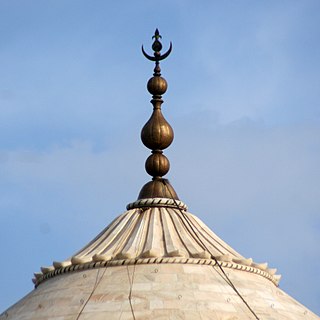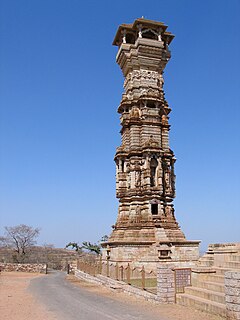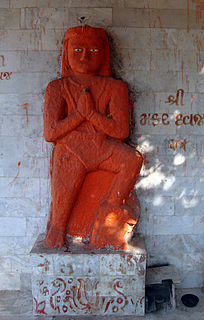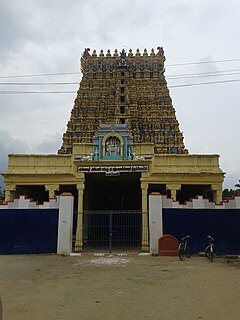
A finial or hip-knob is an element marking the top or end of some object, often formed to be a decorative feature.

A stambha is a pillar or column found in India. In the context of Hindu mythology, it is believed to be a cosmic column that functions as a bond, joining heaven (Svarga) and earth (Prithvi). A number of Hindu scriptures, including the Atharva Veda, feature references to Stambhas. In the Atharva Veda, a celestial stambha has been described as an infinite scaffold, which supports the cosmos and material creation.

Govindavadi is a small village near Kancheepuram temple town in Kancheepuram district in Tamil Nadu, India. Kancheepuram is about 100 km from Chennai and is also famous for its world famous silk sarees. It is also near Agaram.

Birla Mandir is a Hindu temple, built on a 280 feet (85 m) high hillock called Naubath Pahad on a 13 acres (53,000 m2) plot in Hyderabad, Telangana, India. The construction took 10 years and was opened in 1976 by Swami Ranganathananda of Ramakrishna Mission. The temple was constructed by Birla Foundation, which has also constructed several similar temples across India, all of which are known as Birla Mandir.

Dhvaja, meaning banner or flag, is composed of the Ashtamangala, the "eight auspicious symbols".

Hindu architecture is the traditional system of Indian architecture for structures such as temples, monasteries, statues, homes, market places, gardens and town planning as described in Hindu texts. The architectural guidelines survive in Sanskrit manuscripts and in some cases also in other regional languages. These texts include the Vastu shastras, Shilpa Shastras, the Brihat Samhita, architectural portions of the Puranas and the Agamas, and regional texts such as the Manasara among others.

Perur is an ancient village in the State of Telangana, India. It is in the Nalgonda district. Perur is the place of Lord "Swayambhu Someswara swami", this temple of Lord Shiva is a place of traditional worship and treated as very auspicious and powerful.

Mahadeva Temple, Kalanjoor popularly known as Thrikkalanjoor Sree Mahadeva temple is a Hindu temple. It is 80 kilometers to the south-west of the Sabarimala temple on the Punular-Muvattupuzha highway in Pathanamthitta District, Kerala, India. A majestic banyan tree, flanked by an Althara that is visible from a distance for any traveler on the main road, announces the presence of the temple to the devotee.

Sri Radha Krishna-chandra Temple is one of the largest Krishna Hindu temples in the world. It is located at Rajajinagar, in North Bangalore in the Indian State of Karnataka.

Makardhwaja / Magardhwaja as per Hindu scriptures, is born from Hanuman's sweat, who makes his appearance in various regional versions of the Ramayana.

Tiru Pavala Vannam or Pavalavanam temple located in Kanchipuram in the South Indian state of Tamil Nadu, is dedicated to the Hindu god Vishnu. Constructed in the Dravidian style of architecture, the temple is glorified in the Divya Prabandha, the early medieval Tamil canon of the Azhwar saints from the 6th–9th centuries CE. It is one of the 108 Divyadesam dedicated to Vishnu, who is worshipped as Pavalavannar Perumal and his consort Lakshmi as Pavazhavalli.

Jagannath Puri Temple Chennai is a Hindu temple dedicated to the divine trinity Jagannath, Baladeva and Subhadra in Chennai, India. The temple located in Kannathur off the East Coast Road by the seaside is built in Kalinga architecture reminiscent of the Jagannath Temple, Puri. The temple has shrines dedicated to Shiva, Ganesh, Bimala. The annual Rathyatra is the main festival celebrated.
Makar Dhwaja Darogha was an Indian classical dancer and guru, known for his expertise in the classical dance form of Chhau. He died on 17 February 2014 at his residence in Saraikela in Jharkhand, India due to old age illnesses. The Government of India honored him in 2011, with the fourth highest civilian award of Padma Shri.

Adi Kesava Temple is dedicated to Hindu god Vishnu located in Mylapore, Chennai, in the South Indian state of Tamil Nadu. Constructed in the Dravidian style of architecture, dedicated to Vishnu, who is worshipped as Sri Aadi Kesava Perumal and his consort Lakshmi as Mayuravalli Thayar. The temple is believed to be the birthplace of Peyazhwar, one of the first three of the twelve azhwar saints of the 6th-9th century CE.

Tirunatyattankudi Rathnapureeswarar Temple is a Hindu temple located at Tirunattiyathankudi in Tiruvarur district, Tamil Nadu, India. The temple is dedicated to Shiva, as the moolavar presiding deity, in his manifestation as Rathnapureeswarar. He is also known as Manikkavannar. His consort, Parvati, is known as Mangalambikai.

Sathya Vageeswarar Temple in Kalakkad, a village in Tirunelveli district in the South Indian state of Tamil Nadu, is dedicated to the Hindu god Shiva. This Temple is Centered on Kalakad Town, It is located 45 km from Tirunelveli. Constructed in the Dravidian style of architecture, the temple has three precincts. Shiva is worshipped as Sathya Vageeswarar and his consort Parvathi as Gomathi.

Jogulamba temple is a Hindu temple dedicated to Goddess Jogulamba, a form of Shakti located in Alampur, Telangana, India. The temple is one of the Maha Shakti Peethas, a group of eighteen (Ashtadasa) temples considered the most significant shrines and pilgrimage destinations in Shaktism. Alampur is located on the banks of the Tungabhadra river near its confluence with Krishna river. Jogulamba temple is located in the same complex as that of the Navabrahma Temples, a group of nine Shiva temples built in the seventh-eighth century CE.

Swayambhunathaswamy Temple is a Hindu temple located in Peralam in the Mayiladuthurai district of Tamil Nadu, India.

















